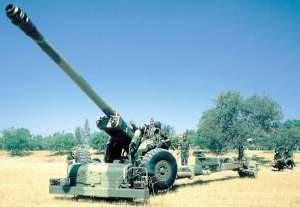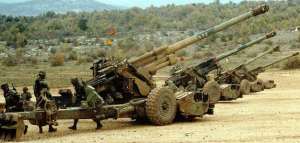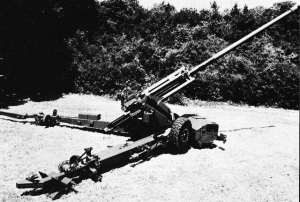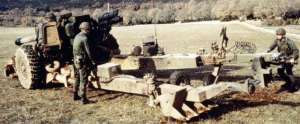| Designation: | TR |
 |
|---|---|---|
| Manufacturer: | Nexter | |
| Product type: | Weapons & Weapon Systems | |
| Name: | Towed gun |
This 155 mm towed gun TR (Le Canon de 155 mm Tracte) was developed by the now Nexter Systems (previously Giat Industries) to meet the requirements of the French motorised infantry divisions and rapid action forces as the replacement for the older 155 mm howitzer Model 50. The weapon was shown for the first time at the 1979 Satory Exhibition of Military Equipment. Following trials with prototype systems, a preproduction batch of six weapons was delivered by the company facility at Bourges for troop trials from December 1987. The main production run commenced in 1989 and a total of 105 weapons were delivered to the French Army.
Export sales of the 155 mm towed gun have been made to at least two countries, Cyprus (12) and Saudi Arabia (28).
The 155 mm towed gun TR was deployed to Saudi Arabia and took part in Operation Desert Storm, the liberation of Kuwait, in the first quarter of 1991.
Although production of this weapon was completed several years ago it can be placed back in production if significant export orders are placed.
Production of components for the 155 mm towed gun TR was undertaken by various Nexter Systems facilities but system's integration was undertaken at Bourges where all French artillery and tank barrels are produced.
The French Army has ordered 72 Nexter Systems CAESAR 155 mm/52 calibre CAESAR self-propelled artillery systems and the first of these were delivered in the first quarter of 2008.
In the future it is expected that the French Army will have a total of eight field artillery regiments, each of which will have three batteries comprised of eight weapons with two troops of four guns each.
Four regiments will have two batteries with a total of 16 upgraded tracked SP AUF1 TA weapons and one battery of eight CAESAR. The remaining four regiments will have two batteries with a total of 16 TR towed guns and one battery of eight CAESARs.
A crew of eight is required for the tractor and gun: commander; layer/gunner who also drives the gun in the self-propelled mode; loader who operates the loading device during firing, controls the raising and lowering of the gun and operation of the trails when moving into and out of action; two men who are responsible for the preparation of the propelling charges and supplying the gun; two loaders responsible for the preparation of the projectiles and supplying the loading mechanism; and finally the tractor driver. If the tasks are divided differently, the crew can be reduced to seven, six of whom serve the gun. If required, the gun can be brought into and out of action by a crew of three.
The 155 mm 39 calibre barrel has a double-baffle muzzle brake which when travelling is swung through 180° and secured in position over the closed trails.
Mounted on the front of the carriage is a 39 hp engine which drives three hydraulic pumps, one for each of the two road wheels and one to provide power for functions such as elevation, traverse, raising the suspension, trail wheel jacks and the loading mechanism. Travelling under its own power the gun has a maximum road speed of 9 km/h, can climb a gradient of 60 per cent and ford to a depth of 1 m in the self-propelled mode and 1.5 m in the towed mode.
In French Army service the 155 mm TR is towed by a Renault Trucks Defense TRM 10 000 (6 × 6) truck which carries the crew of eight and 48 rounds of ammunition. This combination has a maximum road speed of 80 km/h and a road range of 600 km, but it can be towed by various other types of prime mover.
On arriving at the battery position, the weapon is first uncoupled from the prime mover and then the barrel is swung from its travelling position through 180° into its firing position. The wheels are raised off the ground so that the weapon rests on its firing jack under the carriage. The trails are then swung apart, which is a simple operation as castor wheels are fitted on each trail. When opened out, the small wheels are raised clear of the ground and the trails staked into position. The maximum time taken to bring the weapon into battery is 90 seconds and it can be brought out of battery in the same time due to the hydraulic system.
The layer is seated on the left of the mount and has hydraulic aiming controls. The sights, which can be used by day and night, are the GA 81 goniometer, indirect sight and the direct fire telescopic sight. After indicating the elevation angle on a graduated drum, the barrel position is checked using the level shown on the elevating mechanism's elevation meter. The ranging (GR) and firing (GT) angles can be read directly through the goniometric sight. The direct fire telescope can be used to engage targets up to a maximum range of 2,000 m. In an emergency the gun can be fired without the trails being deployed.
The automated hydraulic system for ramming the projectile into the ordnance operates at all angles of elevation, reduces crew fatigue and ensures all projectiles are rammed at the same pressure, giving a stable muzzle velocity. The ramming system permits a high rate of fire of three rounds in the first 18 seconds and 6 rds/min thereafter.
Due to its total interoperability, the 155 mm towed gun TR can fire projectiles with the French or NATO propelling system to the following ranges:
- HE hollow base to 24,000 m
- HE base bleed to 30,000 m
- HE 56/59 to 23,000 m
- HE M107 to 18,500 m
- HE ERFB BB to 32,900 m
- 155 mm HE hollow base shell Type F1 (HE 155 F1) or Type F2 (LU 111 HB) with the projectile weighing 43.25 kg (containing 8.83 kg of HT 50/50), a muzzle velocity of 830 m/s and a maximum range of 24,000 m
- 155 mm phosphorus smoke shell HB Type F2A (OFUM 155 F2A) with the projectile weighing 43.15 kg (containing 8.7 kg of white phosphorus), a muzzle velocity of 830 m/s and a maximum range of 24,000 m
- 155 mm training shell Type F1 (OX 155 F1) with the projectile weighing 43.5 kg (containing 1.2 kg of black powder), a maximum muzzle velocity of 830 m/s and a maximum range of 24,000 m
- 155 mm illuminating shell Type F1 (OECL 155 F1) with the projectile weighing 43.5 kg, a maximum muzzle velocity of 760 m/s and a maximum range of 19,250 m
- 155 mm anti-tank mine shell Type H1 (OMI 155 H1) with the projectile weighing 46 kg. This shell contains six anti-tank mines each weighing 0.55 kg and although fired at a maximum of charge 5, no maximum range has yet been announced
- 155 mm HE BB shell Type H2 (BBE 155 H2) with the projectile weighing 43.5 kg (containing 10 kg of HT 50/50), a maximum muzzle velocity of 830 m/s and a maximum range of 29,000 m
- Nexter Munitions cargo round projectile OGRE 155 G1 containing 63 bomblets with a maximum range of 28,500 m
The TR will also fire the more recent Nexter Munitions/BAE Systems Bofors BONUS 155 mm artillery projectile, which contains two top attack sub-munitions. This is now in service with France and Sweden.
Nexter are now delivering to the French Army the latest version of their well established LU211 high-explosive projectile manufactured to the insensitive munition (IM) standard.
This is designated the 155 LU211-IM which meets the STANAG 4224 and STANAG 4439 requirements. The French Army has ordered an initial batch of 5,000 projectiles.
The TR has been provided with a number of emergency systems to allow continued use in the event of damage. These are a battery for the hydraulics which makes it possible to fire a further six rounds, or take the weapon out of action if the thermal engine stops, connection of the gun to the tractor's hydraulic system powering all of the gun's firing operations and coming into and out of action (or two guns can be connected together), manual pumps for elevation and traverse and manual mechanisms for traversing, opening and closing the breech and firing.
According to Nexter Systems, upgrades settled during 2003 on 155 mm TR weapons in service with the French Army included the means to improve reliability, security, ergonomics and interoperation of the fire-control system. These could also be offered to export customers of the TR.
A prototype was completed and tested but marketing is now being concentrated on the 155 mm 52 calibre system.
In 1990, the now Nexter Systems announced that it had completed the prototype of a 155 mm towed gun TR with a 52 calibre ordnance that enables a range of 30,000 m to be achieved with basic projectiles and 42,000 m with ERFB-BB projectiles. This conforms to the new NATO ballistic MoU and was fired for the first time early in 1990.
The main modifications include replacement of the barrel by the new 52 calibre ordnance, modified towbar, modified rammer and some modifications to the recoil system.
The 155/52 has similar specifications to the 155/39 except that it is slightly longer in the firing position and weighs 11,000 kg.
The complete upper part of the 155/52 calibre weapon forms the basis of the Nexter Systems CAESAR 155 mm (6 × 6) self-propelled artillery system which was first shown in 1994. The French Army has ordered 72 production CAESAR self-propelled weapons on a new Renault Trucks Defense chassis (6 × 6).
|
||||||||||||||||||||||||||||
|
||||||||||||||||||
 |
 |
 |
 |
 |



